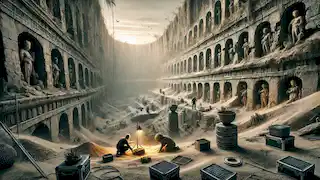In the fertile valley of Mesopotamia, cradled between the Tigris and Euphrates Rivers, the city of Babylon rose to dominate the ancient world. It was a city steeped in history, culture, and myth. At its height, Babylon was a symbol of power, wealth, and architectural brilliance, known for its towering ziggurats, massive city walls, and monumental structures. But none captured the imagination of both ancient and modern minds quite like the legendary Hanging Gardens of Babylon, a wonder so unique and extraordinary that it came to be listed as one of the Seven Wonders of the Ancient World.
The tale of the Hanging Gardens, though shrouded in mystery, begins with King Nebuchadnezzar II. His reign from 605 to 562 BCE transformed Babylon into the most splendid city of its time. Yet, despite his military conquests and his architectural triumphs, it was an act of love that led to the creation of the Hanging Gardens. Nebuchadnezzar's beloved wife, Queen Amytis, hailed from the green and mountainous lands of Media, far to the north of Babylon. Media was a land of cool breezes, tall trees, and rolling hills—a landscape that sharply contrasted with the flat, arid plains of Babylon. Amytis missed her homeland deeply. Though she was queen of one of the most powerful empires on earth, she longed for the sights, smells, and sounds of her native mountains, where lush greenery flourished, and streams flowed abundantly. Nebuchadnezzar, a king known for his strategic mind and his devotion to his queen, could not stand to see her so despondent. He understood that, despite the grandeur of Babylon, it could not compete with the natural beauty that Amytis cherished. And so, he conceived of a grand idea—an idea that would not only bring joy to his queen but also stand as an eternal symbol of his love and his kingdom’s power. He would bring the mountains of Media to Babylon. He would create an oasis of greenery and life in the heart of the desert, a verdant paradise that would mimic the slopes of Amytis’s homeland. This would be no ordinary garden—it would be a towering, multi-level marvel, filled with trees, flowers, and cascading waterfalls. It would be an engineering feat so grand that it would defy the very landscape of Mesopotamia. Thus, the seeds for the creation of the Hanging Gardens were sown. To bring this audacious dream to life, Nebuchadnezzar called upon the finest engineers, architects, and artisans from across his empire. These men were tasked with a monumental challenge: how to build a garden that would not only rise high into the sky but also flourish in the dry, sunbaked climate of Babylon. The concept of the gardens was revolutionary. Instead of a flat garden on the ground, the Hanging Gardens would be constructed as a series of terraces, each one stacked upon the other like steps leading to the heavens. These terraces would be supported by massive stone columns and beams, creating the illusion that the gardens were "hanging" in midair. From the ground, it would look as though a mountain of greenery had sprung up from the earth, defying both gravity and the desert heat. Each terrace was to be filled with soil deep enough to plant trees, bushes, and a variety of flowering plants. The terraces would gradually ascend, with the highest levels towering over the city walls, offering a breathtaking view of the surrounding landscape. To ensure the gardens would thrive, a sophisticated irrigation system would be developed, one that could carry water from the Euphrates River to the highest terrace. It was a feat of engineering as much as it was a testament to Nebuchadnezzar's power and ambition. The idea of transporting large amounts of water to such heights presented one of the greatest challenges. Babylon was a city of scorching heat, where water was a precious resource. Yet, the Euphrates River, flowing close to the city, provided a potential solution. Engineers devised an ingenious system of waterwheels, pulleys, and aqueducts to raise the water from the river, channeling it up to the terraces. Using this method, they could keep the gardens lush and green, even in the hottest months of summer. The process of constructing the gardens took years, with thousands of workers laboring day and night to complete Nebuchadnezzar's vision. Stone by stone, the terraces were raised, and earth was piled onto each level to create planting beds deep enough for the roots of large trees. Exotic plants and trees were brought from far-flung regions of the empire, including Media, Persia, and even the distant lands of India and Africa. The gardens began to take shape, an Eden in the heart of Babylon. When the gardens were finally completed, they were unlike anything the world had ever seen. Rising some 75 feet into the air, the Hanging Gardens of Babylon were a marvel of both nature and engineering. The terraces were filled with lush greenery, from fragrant roses to towering palms. Figs, pomegranates, and date trees grew alongside exotic flowers, their vibrant colors contrasting with the stone columns and the blue sky above. Water cascaded down the terraces, flowing from one level to the next, creating a network of streams and pools that not only irrigated the plants but also provided a soothing backdrop of sound. The scent of jasmine, lilies, and myrtle filled the air, mingling with the sweet fragrance of fruit trees and herbs. Birds, drawn by the abundance of food and water, flocked to the gardens, filling the air with their songs. Queen Amytis was overjoyed. As she walked among the terraces, she was transported back to the mountains of her homeland. Here, in the heart of the desert, Nebuchadnezzar had recreated a piece of the Media for her. From the highest terrace, she could look out over the vast city of Babylon and the shimmering Euphrates, her heart at peace in the paradise her husband had built. The gardens were not just a personal gift to the queen; they quickly became the pride of Babylon and a symbol of the empire's greatness. Travelers from across the known world came to see the gardens, and their descriptions of the sight were nothing short of awe-inspiring. They spoke of the towering terraces, the streams of water that seemed to flow magically uphill, and the abundance of life that thrived in the desert. The Greek historian Strabo, who would later write of the gardens, described them as "a work of art, with plants of every variety growing along terraces that seem to hang suspended in the air." He marveled at the ingenuity of the Babylonians in harnessing the power of the Euphrates to water the garden's vast expanse. Though built for Queen Amytis, the Hanging Gardens of Babylon were much more than a gift of love. They were a statement of Nebuchadnezzar’s power, a symbol of his ability to conquer not only other lands but also nature itself. The gardens represented the king’s dominion over his empire and his ability to bend even the most inhospitable environments to his will. In creating such a paradise, Nebuchadnezzar demonstrated to both his people and the wider world that Babylon was not only a center of military strength but also of culture, beauty, and innovation. The gardens were also deeply symbolic of the king's divine favor. In ancient Mesopotamia, rulers were seen as intermediaries between the gods and the people, and Nebuchadnezzar was no exception. By creating the Hanging Gardens, he was not only pleasing his queen but also honoring the gods, particularly Marduk, the patron deity of Babylon. The gardens, with their life-giving water and bountiful plant life, were seen as a reflection of the gods’ favor upon the city. To many Babylonians, the Hanging Gardens were a place of spiritual significance. They believed that by tending to the plants, they were participating in a sacred act, helping to sustain the beauty of the world created by the gods. Pilgrims and travelers alike would visit the gardens to offer prayers and gifts to the deities, believing that the lush paradise was a piece of the divine on earth. But like all great empires, Babylon’s golden age was not to last forever. In 539 BCE, the city was conquered by the Persian king Cyrus the Great. The fall of Babylon marked the end of the Neo-Babylonian Empire and the beginning of Persian rule over Mesopotamia. Yet, despite the change in leadership, the city remained an important cultural and religious center for many years. Cyrus, a wise and strategic ruler, spared the city from destruction. The Hanging Gardens, along with the other great monuments of Babylon, were preserved under his reign. However, over the centuries that followed, the glory of Babylon began to fade. The city's political and economic importance waned, and with it, the resources needed to maintain the grand structures that had once defined the empire. The irrigation systems that had once kept the Hanging Gardens alive began to deteriorate. Without regular maintenance, the waterwheels and pulleys that had carried water to the terraces fell into disrepair. As the desert reclaimed the land, the plants withered and died. The once vibrant and flourishing gardens were slowly reduced to dust and ruin, their memory preserved only in the stories of those who had witnessed their beauty. As time passed, the Hanging Gardens of Babylon became more legend than reality. The great city of Babylon itself fell into ruin, its monuments crumbling under the weight of centuries. By the time Alexander the Great arrived in Babylon in 331 BCE, the city was but a shadow of its former self. Alexander, enamored by the stories of Babylon's past glory, had hoped to restore the city to its former greatness. Yet even he could not halt the march of time, and after his death, Babylon’s decline continued. For centuries, the story of the Hanging Gardens persisted, passed down through the writings of historians and travelers. Yet, despite the detailed descriptions left behind, no definitive evidence of the gardens has ever been uncovered. Excavations of ancient Babylon have revealed much about the city’s layout, including its temples, palaces, and streets, but the Hanging Gardens remain elusive. Some scholars even argue that the gardens may never have existed at all, suggesting that they were a myth or a misinterpretation of another structure. Others propose that the gardens may have been located elsewhere, possibly in the Assyrian city of Nineveh. King Sennacherib, a ruler of the Assyrian Empire, was known to have constructed a grand garden at his palace, complete with advanced irrigation systems similar to those described in the accounts of the Hanging Gardens. Could it be that the gardens of Babylon were, in fact, the gardens of Nineveh? The answer remains a mystery. Though the true fate of the Hanging Gardens may never be known, their legacy lives on in the imagination of the world. They continue to inspire awe and wonder, a symbol of human ingenuity and the power of love. The story of Nebuchadnezzar’s devotion to Queen Amytis, and his determination to recreate the beauty of her homeland, resonates across time, a reminder of the lengths to which we will go to bring joy to those we love. Even today, the Hanging Gardens serve as a symbol of humanity’s desire to create beauty, to conquer the harshest environments, and to build lasting monuments to our ambitions. Whether or not they existed in the form described by ancient historians, their story continues to captivate the minds of historians, archaeologists, and dreamers alike. The Hanging Gardens of Babylon may remain one of history's greatest mysteries, but their story endures as a testament to the grandeur of the ancient world. They represent the fusion of nature and human innovation, the triumph of will over the forces of the desert. Whether real or imagined, the tale of the Hanging Gardens will continue to be told, passed down from generation to generation, as a symbol of the eternal desire to create something beautiful, lasting, and extraordinary.A Queen's Longing
The Vision of the Gardens

A Living Miracle

The Gardens as a Symbol of Power
The Fall of Babylon

Lost to History
The Legacy of the Hanging Gardens

Conclusion


















